
Vneauditornye_texty
.pdfConstruction of Aircrafts
In the dynamic world of today, aviation provides a rapid transportation link between different population centers, comple menting a road and rail transportation network. In many places
the airplane is the only known vehicle for the large-scale movement of passengers and freight over large distances.
The major components of airplanes can be divided into six main parts: fuselage, wings, empennage, flight controls, landing gear or floatation gear, and nacelles. (See Fig. 1.)
The fuselage is the main body of the airplane and contains the pilot's compartment (cockpit) and passenger and baggage compartments. The cockpit contains the flight controls and instruments. The larger part of the fuselage contains passenger seats or cargo space and usually some provision for baggage.
The wings are the main lifting surfaces which support the aircraft in flight, and they are attached to a strongly-built or stressed section of the fuselage.
The empennage, more commonly known as the tail section, consists of a vertical stabilizer and rudder and the horizontal stabilizer and elevators.
The three basic flight control surfaces are the ailerons, the elevators, and the rudder.
The ailerons are located at the trailing edge and near the tips of the wings. When one is raised, the other lowers, and the airplane banks or rolls. The lowered aileron increases l i f t causing the wing to rise, while the raised aileron reduces lift, causing that wing to drop. These modifications to the airfoil impose additional drag. The lowered aileron presents a relatively greater amount of drag than the raised aileron, resulting in a tendency to skid. To overcome this, a differential control mechanism causes the up-aileron to move a greater distance than the down-aileron for a given control movement.
The elevators are hinged to the horizontal stabilizer and control the airplane's movement up and down about the lateral axis. When the control stick is moved forward, the elevators lower, and the airplane dives, and vice versa. Because more force is necessary to climb than to descend, on most airplanes the maximum number of degrees the elevators can be raised is greater than the maximum number of degrees they can be lowered. Thus, the stick can be pulled back farther than it can be pushed forward. Where necessary, the pilot is aided in moving this control by a differential mechanism. Many newer aircraft possess a different method of controlling pitch. This method combines the horizontal stabilizer and the elevators into a single surface known as the controllable horizontal tail.
This surface gives easier manoeuvring of the aircraft at transonic speeds. The whole surface can be repositioned from the cockpit when inflight trimming is necessary.
The rudder is hinged to the vertical stabilizer (fin), and it controls the movement of the airplane around the vertical axis. The right pedal moves the rudder and the aircraft to the right. The left pedal works similarly.
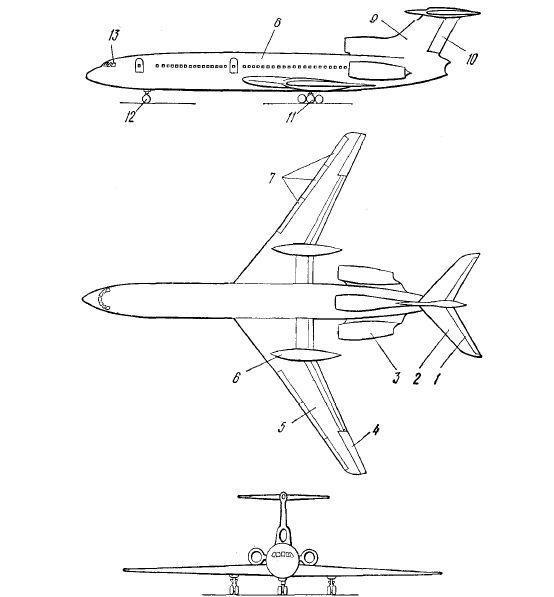
The main landing gear or wheels are attached by struts and braces to the fuselage and often to the wings outboard of the fuselage. Usually a smaller wheel supports either the nose or tail of the airplane.
Flotation gear for landing on water consists of pontoons or floats. Some airplanes are equipped with skis for landing on snow.
Nacelles are compartments housing the power plant or engine and its accessories. The nacelle is usually covered with a detachable cowling and contains a framework or engine mount which is attached to the fuselage or airframe.
Fig. 1. Turbojet Airplane Components
1 — elevator; 2— stabilizer; 3 — engine nacelle; 4 — aileron; 5 — wing; 6 — undercarriage housing; 7 — leading edge flaps; 8 — fuselage; 9 — fin; 10 — rudder; 11 — main undercarriage wheels; 12 — nose wheels; 13 — crew's canopy
.........................................................
5. Wher e are the ailero ns locat ed? 6. What do the eleva tors contr ol? 7. What does the rudde r contr ol? 8. What
supports the nose or tail of the airplane?
9.What are some airplanes equipped with for landing on snow?
10.What do nacelles house?
AIRPORT
An airport is a location where aircraft such as fixed-wing aircraft, helicopters, and blimps take off and land. Aircraft may be stored or maintained at an airport. An airport consists of at least one surface such as a runway, a helipad, or water for takeoffs and landings, and often includes buildings such as hangars and terminal buildings.
Larger airports may have fixed base operator services, seaplane docks and ramps, air traffic control, passenger facilities such as restaurants and lounges, and emergency services. A military airport is known as an airbase or air station. The terms airfield, airstrip, and aerodrome may also be used to refer to airports, and the terms heliport, seaplane base, and STOL port refer to airports dedicated exclusively to helicopters, seaplanes, or short takeoff and landing aircraft. In some jurisdictions, the term airport is used where the facility is licensed as such by the relevant government organization (e.g. the U.S. Federal Aviation Administration (FAA), Transport Canada). Elsewhere the distinction is one of general appearance. Other jurisdictions define an airport by its having the customs offices etc expected of a port though the more general term is airport of entry.
Airports
There are many airports in our country. There are some inter national airports. There is an aerodrome, a terminal, some buildings and offices at the airport; on the aerodrome there are some taxi ways and runways. Runways are 2,000 km long and more. Some taxiways are long, other taxiways are short. There are hangars there. There are beacons, too. At the; terminal there is an apron, on it there are many stands for aircraft and there are pads for helicopters. At every aerodrome, there is a meteorological office, a tower and a fire station. There is a settlement for the personnel and a hotel for passengers and crews at every airport. The airport is not far from the city. It doesn’t take much time to get to the airport. It may be a 20 – 40 minute drive by bus or train.
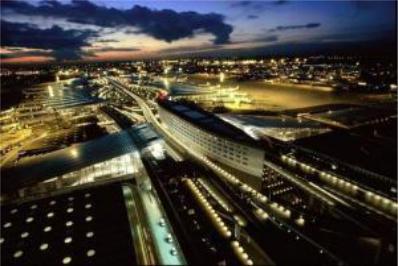
Frankfurt airport
Frankfurt Airport is airport number 3 in Western Europe. There are about 5,000 flights to and from some 170 cities in 80 countries every week. There are 40,000 passengers a day. Boeing 747 planes land and takeoff here. This aircraft is for 490 passengers. There’s a new terminal for 24 million passengers. There are 3 landing areas for 36 aircraft. There’s a special hangar for B-747. There’s a control tower 34 m high. There are 900 air traffic specialists to control flights.
Paris airport
.
Paris Airport consists of three airports: Orly, Bourge and Roissy. Orly and Bourge service Paris and its area. The aircraft of 160 air companies make regular flights to these airports. Over 13 mil passenger; use the airport every year and every year about 300,000 aircraft take off and land here. Now the airport has modern equipment and technical buildings to control the aircraft of all types. In Orly there are four runways and a control tower controlling the traffic in the airport area. The passenger terminal building services over 10 mil passengers a year. The area of Bourge airport is smaller, there are two runways. It services over 3 mil passengers a year. At Bourge Airport there is the International Exhibition Area. Aviation and Space Equipment Show takes place every two years. Roissy is a new airport. Its area is 3,000 hectares. It services over 50 mil passengers and 2 mil tons of cargo a year. To service such a number of passenger; the airport has five runways, four of which are parallel. 150 planes take off and land here every hour. The passenger terminal is very comfortable. There is everything to take a passenger from a car to the aircraft quickly and comfortably.
Modern airports
The modern airport is a center of most diversified services. Among the airport services are: flight assistance service, air traffic control – airport traffic control, approach control, air route traffic control; radio communications and weather service observation and forecasting. The airport has to maintain a num8 ber of supplementary services – risqué and security services. There must be an airport clime, a fire brigade, special vehicles and equipment units (water trucks, catering trucks, air freight and baggage handling units, tow tractors for moving aircraft to the apron). Other services cover maintenance, overhaul and repair of stationary and mobile equipment, the supply of electricity, water, heat and air conditioning. There is the Aircraft
Maintenance Base with many maintenance specialists. There’s the fuel supply center with underground pipelines. The facilities include runways, air navigation aids, and passenger and cargo terminal buildings. The airport offer: a hotel, a post office, bank offices, restaurants, snack bars, car rental firms and a number of other facilities from pharmacy to the travel office, from the barber and beauty shop to the supermarket and waiting lounges. There must be everything for quick passenger handling. The modern passenger air terminal operates a-dozen of services. In the reception, halls at die check-in desks the suitcases are weighed and labeled. Baggage check-in facilities utilize conveyors to move baggage without delays. In the terminal there’s an electronic flight information board to list departure and arrival times. Near the board (here are departure areas for passengers to board their flights. Passengers board the aircraft via loading bridges (passageways or fingers). The baggage claim carousel is on the lower floor. Flight numbers enable passengers to find their luggage location easily. It has become difficult for travelers to locate various facilities and services they need. The ICAO Council has developed uniform signs for use at international airports to facilitate travelers: ARRIVALS; DEPARTURES; FIRST AID; NURSERY POINT; PASSENGER CHECK-IN; ELEVATORS; HOTEL RESERVATIONS; LOST AND FOUND; LEFT LUGGAGE and so on.
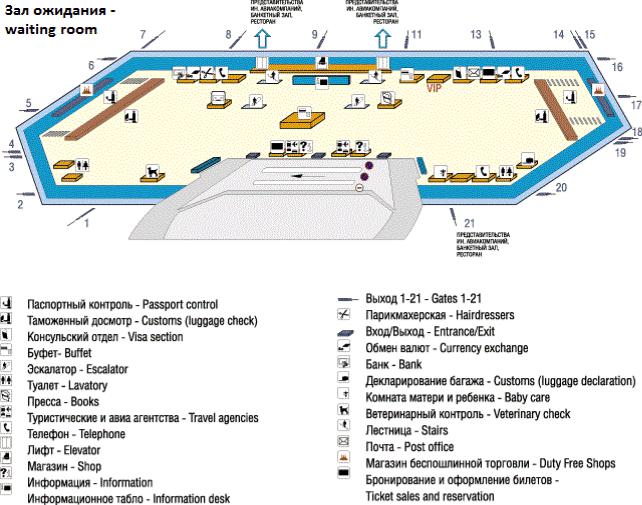
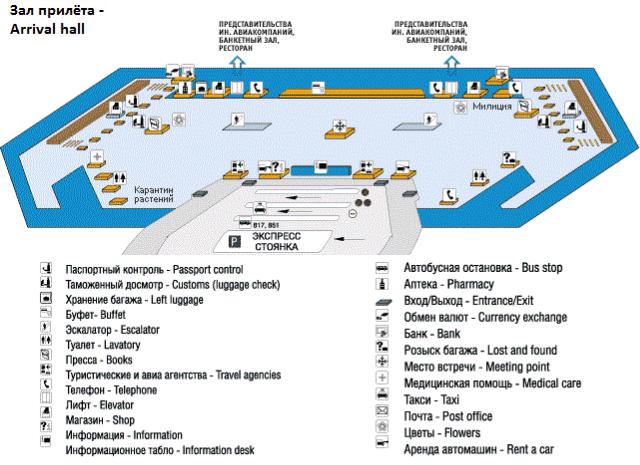
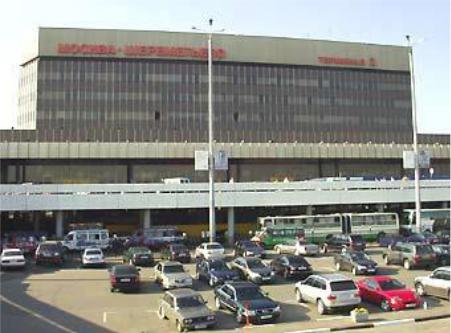
Sheremetyevo
The capacity of Sheremetyevo Airport has increased. The terminal can receive up to 2,100 passengers every hour; the total capacity of the complex is 15 mil passengers a year. Sheremetyevo II is situated 28 Ian northwest, of Moscow. It is the centre of international air traffic of Russia. Sheremetyevo II was inaugurated in 1980, its capacity is 2,100 passengers an hour, and it can handle 6 mil passengers a year. It’s a 9-storey building with 19 telescopic ladders (fingers). It has been assembled by the West German firm. It has the most up-to-date equipment for handling passengers. There is a new runway which can handle all types of aircraft. Radio navigation equipment and the traffic control system have been modernized. The new check-in counters, computers and 10 automatic luggage conveyors cut the time needed for receiving passengers and handling luggage down to 5 minutes. The automatic baggage conveyors reduce luggage waiting time after arrival to 7 minutes. There are halls for passengers, 4 restaurants, a banquet hall, bars, snack bars to cater for 1,600 passengers at a time. There’s a conference hall for 500 seats. There’s a hotel for 500 transit passengers, a modern complex for centralized fueling of aircraft, engineering communications and other facilities. There are arrivals, departures, transit and waiting halls in the terminal. The terminal has all the latest equipment to handle numerous passengers, much cargo and baggage. Boarding is done through one of the 19 passages (telescopic gangways). There are foreign airline offices, on the upper floors. There is a parking place for 1,200 cars. It takes only 35 minutes to get to the centre of the city. Ticket registration and luggage weighing and labeling are computerized. There’s the computer information system to provide passengers with necessary flight information. Passengers can make a long-distance telephone call; send a cable, exchange currency, buy souvenirs and other goods at the duty-free
shops. There are two sections for kids with sleeping rooms and playgrounds. Payment of shipment is accepted in cash, che12 que or letter of credit. Sheremetyevo-I, Domodedovo, Vnukovo were used for domestic lines only; Sheremetyevo-II is one of four major airports in Europe.
Airports of the UK
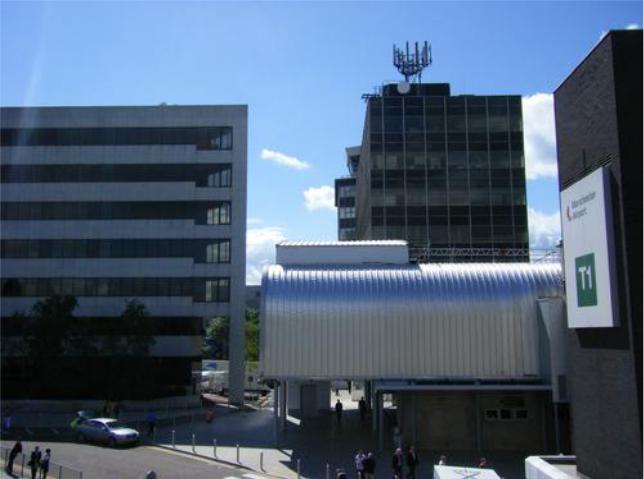
There are 8 major airports in Britain – Heathrow, Gatwick, Stansted Southampton, Prestwick, Glasgow, Edinburgh and Aberdeen. Southampton airport was purchased in 1990 by BAA. The seaport has an old terminal building which was built in 1917. Their plan is to replace completely all the airport facilities. The plan costs $ 20 million. There will be a new passenger terminal, a control tower, car parking areas – a completely new airport will be built around the old runway. There is a station which provides 55-minute non-stop train services to London. Southampton is the UK’s fastest growing airport. They have installed an instrument landing system. A new hotel is to be bunt next to this terminal. Local people can fly to European destinations from Southampton. Southampton has become an important air freight centre.
Traffic has greatly increased. They have introduced a weekly transatlantic service. Flights are to operate non-stop to Toronto. New facilities are installed including shops and catering points. Stansted is one of the most comfortable and easy to use airports. Departures are on the left, arrivals on the right. Everything you need is on one level. Passengers walk from the entrance through check-in, security and Passport Control to the departure lounge, the distance of 150 meters. From the departure lounge an automatic transit sate system will carry passengers quickly to the apron where they’ll board their plane. Stansted is ideally located; it takes 41 minutes by train from London. There are 12 new European destinations and holiday flights are also offered.
